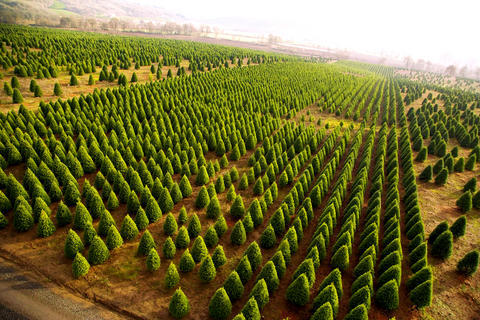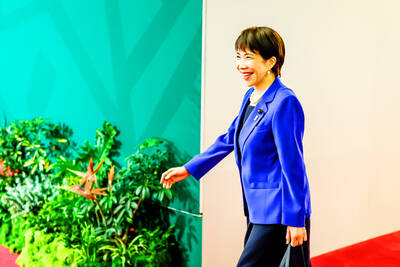A battle is being waged for the heart of the US Christmas tree customer, pitting the real evergreen against the once-lowly artificial tree.
Last year, an estimated 9.3 million artificial trees were sold in the US, up 2 million from five years ago. And while the real tree harvest was triple that, the numbers are of major concern for growers because artificial trees can be used year after year.
It has reached a point where half the trees put up in US households are made of plastic, industry watchers say. The rest of the bad news for growers is that it is getting harder to tell which trees are real.

PHOTO: NY TIMES NEWS SERVICE
China produces a vast majority of the artificial trees, which has tree growers preaching the gospel of "buy natural, buy American" in an effort to fend off claims by the artificial camp that cutting down trees is an environmental travesty.
"It's important to dispel the myth that cutting Christmas trees causes deforestation," said John Schuler, whose family owns Holiday Tree Farms in Corvallis. "It's a crop, just like corn."
The artificial-tree camp, meanwhile, claims that growers have resorted to scare tactics, warning about lead in the manufactured products while playing down the use of pesticides on the tree farms.
This year, the National Christmas Tree Association prepared a point-by-point chart comparing real and plastic trees.
"It's an attempt to make it a simple apples-to-apples comparison," said Rick Dungey of the tree group, based in Missouri. "Once you see the difference, it becomes a pretty clear choice."
Not so, said Thomas Harman of Balsam Hill Trees, a high-end artificial tree company that prides itself on being able to pass off its creations as the real thing. Harman said the bottom line was whether customers want convenience over the real thing
"The main advantage of an artificial tree is that you can put it up before Thanksgiving and put it away after New Year's," Harman said. "You never have to deal with needles or sap."
Whatever the case, the number of artificial trees continues to grow and sales of real trees have been flat in recent years.
But in the long view, plastic versus natural is just another chapter in the Christmas tree's rich history.
First popularized by the Germans, the Christmas tree has taken on some unusual looks, including being hung from the rafters with an apple attached to a sharpened tree butt. The Germans brought their tradition to the New World, but it was hardly quick to catch on, given the strong influence of Puritanism.
Among the first to see there was money to be made was a New Yorker named Mark Carr, who in 1851 filled two ox sleds with evergreens from the Catskills, loaded them on a steamboat and took them 110km to New York City. By 1880, more than 200,000 trees were being shipped to New York each year.
In 1955, Hal Schudel, the founder of Holiday Tree Farms, now perhaps the world's largest Christmas tree grower, began harvesting trees in the Willamette Valley as a way of supplementing his income as an agronomist at Oregon State University.
This year, Holiday will harvest more than 1 million trees, so the pace is frenetic at staging areas here, about 25km west of Salem and all over the valley. Kyle Gunsauls has been jockeying his helicopter from dawn to dusk, dropping just-cut trees from Holiday's lots into waiting trucks before racing back for more.
"No one wants a tree the day after Christmas," Gunsauls said.
Containers to the Philippines, Japan and Pago Pago are long gone, but many orders, most from California, remain.
"It's like getting a freight train moving," said Eugene Carson, who has overseen Holiday shipments for 27 years. "Everything has to be in sync."
That's true all over the country. About 182,000 hectares of land in the US are devoted to growing Christmas trees.
Operations range from megagrowers like Holiday to mom and pop farms in all 50 states. Last year's harvest of 28.6 million trees had a retail value of US$1.2 billion.
Now, the back country roads here are filled with thousands of hectares of trees. An independent grower, Jan Hupp, was harvesting at his farms near Drakes Crossing, a dot in the road in the heart of Christmas tree country.
Hupp drove past a 2 hectare plot where more than 2 million of his seedlings were growing, then on to fields with row after row of perfectly trimmed firs. Talk turned to how the area had once produced strawberries, then grass seed and, finally, Christmas trees. And with talk of trees came the inevitable mention of the artificial competition. Like other growers, Hupp can barely suppress his disdain.
"You can have a natural product or a petroleum-based product in your house," he said. "Are you going to send your wife plastic flowers or fresh-cut roses?"

LIMITS: While China increases military pressure on Taiwan and expands its use of cognitive warfare, it is unwilling to target tech supply chains, the report said US and Taiwan military officials have warned that the Chinese People’s Liberation Army (PLA) could implement a blockade within “a matter of hours” and need only “minimal conversion time” prior to an attack on Taiwan, a report released on Tuesday by the US Senate’s China Economic and Security Review Commission said. “While there is no indication that China is planning an imminent attack, the United States and its allies and partners can no longer assume that a Taiwan contingency is a distant possibility for which they would have ample time to prepare,” it said. The commission made the comments in its annual

DETERMINATION: Beijing’s actions toward Tokyo have drawn international attention, but would likely bolster regional coordination and defense networks, the report said Japanese Prime Minister Sanae Takaichi’s administration is likely to prioritize security reforms and deterrence in the face of recent “hybrid” threats from China, the National Security Bureau (NSB) said. The bureau made the assessment in a written report to the Legislative Yuan ahead of an oral report and questions-and-answers session at the legislature’s Foreign Affairs and National Defense Committee tomorrow. The key points of Japan’s security reforms would be to reinforce security cooperation with the US, including enhancing defense deployment in the first island chain, pushing forward the integrated command and operations of the Japan Self-Defense Forces and US Forces Japan, as

IN THE NATIONAL INTEREST: Deputy Minister of Foreign Affairs Francois Wu said the strengthening of military facilities would help to maintain security in the Taiwan Strait Japanese Minister of Defense Shinjiro Koizumi, visiting a military base close to Taiwan, said plans to deploy missiles to the post would move forward as tensions smolder between Tokyo and Beijing. “The deployment can help lower the chance of an armed attack on our country,” Koizumi told reporters on Sunday as he wrapped up his first trip to the base on the southern Japanese island of Yonaguni. “The view that it will heighten regional tensions is not accurate.” Former Japanese minister of defense Gen Nakatani in January said that Tokyo wanted to base Type 03 Chu-SAM missiles on Yonaguni, but little progress

NO CHANGES: A Japanese spokesperson said that Tokyo remains consistent and open for dialogue, while Beijing has canceled diplomatic engagements A Japanese official blasted China’s claims that Japanese Prime Minister Sanae Takaichi has altered Japan’s position on a Taiwan crisis as “entirely baseless,” calling for more dialogue to stop ties between Asia’s top economies from spiraling. China vowed to take resolute self-defense against Japan if it “dared to intervene militarily in the Taiwan Strait” in a letter delivered Friday to the UN. “I’m aware of this letter,” said Maki Kobayashi, a senior Japanese government spokeswoman. “The claim our country has altered its position is entirely baseless,” she said on the sidelines of the G20 summit in Johannesburg on Saturday. The Chinese Ministry